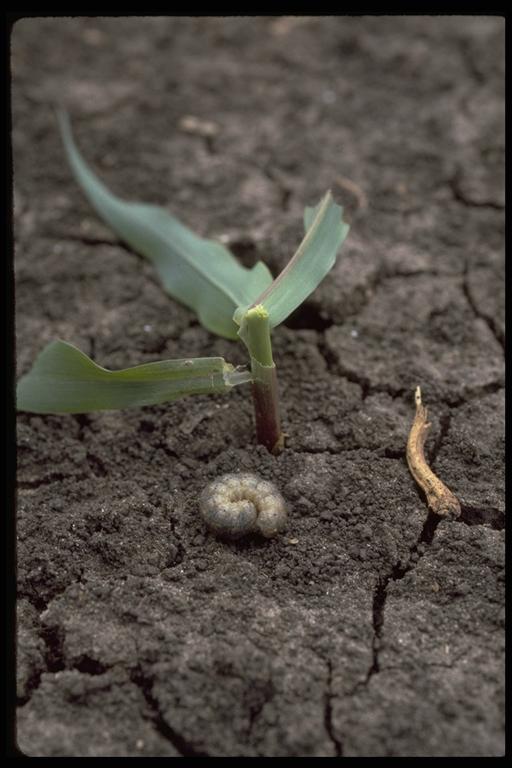
A cutworm (Lepidoptera: Noctuidae), on corn.
Photo by Drees.
Common Name: Cutworm
Scientific Name: Varies
Order: Lepidoptera
Description: Caterpillars are dingy, grayish-black and smooth-skinned that may reach 1 ½ inch in length. They are active at night and spend the day under debris on the soil away from light. When disturbed, the caterpillars curl up tightly into a C shape. Adults are dingy, grayish-brown moths marked with light or dark spots on the wings. They have a wing spread of 1 to 2 inches.
There are four major groups of cutworms based on habitat and feeding behavior:
1) subterranean cutworms, such as the pale western cutworm, Agrotis orthogonia (Morrison), that feed almost entirely below the soil surface on roots and underground stems;
2) tunnel dwellers such as the black cutworm, Agrotis ipsilon (Hufnagel), which cuts a tender plant at the soil surface, pulls it into the tunnel and devours the plant;
3) surface feeders such as the granulate cutworm and the army cutworm, Euxoa auxiliaris (Grote); and
4) climbing cutworms such as the variegated cutworm, Peridroma saucia (Hübner), which can devour the spring buds of grapes.
The army cutworm overwinters in the mountains of west Texas as adults. It can be very numerous and a nuisance in buildings. Adult moths that are about one to two inches in size are often referred to as “millers” or miller moths. This is a generic term and the moths are often in the family Noctuidae which includes cutworms, armyworms, bollworm and many other species.
Life Cycle: The winter is spent in the larval stage. After emerging from the pupa (cocoon), mated female moths deposit eggs that hatch into larvae (caterpillars) which develop through several larval stages (instars) before pupating in the soil. There may be three to five generations per year in central and south Texas, depending on weather conditions and temperature.
Habitat and Food Source(s): Caterpillars have chewing mouthparts. Adults have siphoning mouths. The granulate cutworm is a surface-feeding cutworm. Like other species, it spends the winter months as a partially grown larva in the soil, feeding of weeds and grasses at night. In the spring when gardens and fields and plowed and planted, caterpillars that were feeding on weeds and other host plants move to young plants and transplants. Caterpillars cut off small plants at or near the soil surface and feed on them during the night. In field crops, damage usually appears as skips or sections of rows where all plants are missing. Caterpillars can do tremendous damage in a short period of time. Many turf, forage, ornamental and vegetable plants are attacked, particularly cabbage and tomato transplants and corn seedlings. Caterpillars may be found by raking soil around damaged plants or turning over debris on the ground under which caterpillars hide during the day. Adult moths are attracted to lights at night.
Pest Status: Caterpillars chew on stems and leaves of plants; medically harmless.
For additional information, contact your local Texas A&M AgriLife Extension Service agent or search for other state Extension offices.
Literature: Stewart 1985.